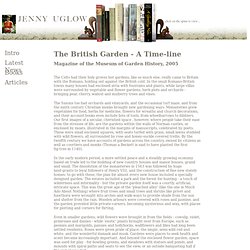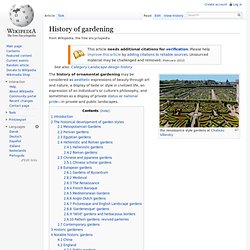

Www.bl.uk/bipc/pdfs/Horticulture_Industry_Guide.pdf. Www.hortforum.net/uploads/7/2/9/5/7295387/nhf_new_vision_for_horticulture_rd.pdf. Gardens of the Future: Edible Landscaping. UC Cooperative Extension There is growing awareness of issues related to healthy eating to combat lifestyle diseases and obesity, as well as the need to save money during difficult economic times.

This has led to increased interest in the concept of Edible Landscaping, using vegetables and fruits as landscape plants as part of a garden design, not just in the countryside, but in urban backyards as well. First popularized by garden and food writer Rosalind Creasy, Edible Landscaping is now advocated by many gardening authorities and educators, including the University of California Division of Agriculture and Natural Resources (UC ANR). There are many ways to practice Edible Landscaping, even for those who may lack the luxury of a large space or excess spare time to dedicate a garden solely to vegetables and fruits, or prefer to emphasize more traditional ornamental plants.
The workshop is free; however a $5.00 donation is suggested to cover printed materials. Dig for The Future - Rocket Gardens in School - Grow your own organic fruit, herb and veg plants with a Rocket Garden. Schools Gardens We launched our schools campaign, ‘Dig For The Future’ in early 2007, as a way to encourage schools to get children growing organic vegetables.

Learning through doing... the muddy boots approach. In the first year, we had requests for our plants from more than 4000 schools nationwide. And in response, we created a garden specifically designed with schools in mind. The garden is full of a wide variety of colourful vegetable and fruit plants, especially chosen to expose children to different varieties and tastes. Care has been taken to choose plants that will harvest during term time, so that the children’s enthusiasm doesn’t have time to wane. What’s in a Schools Garden? For our schools gardens, care has been taken to select varieties that will harvest before the Summer and Christmas holidays.
Don’t just take our word for it... Key Dates in Renaissance History. History of gardening - Encyclopedia Article. Gardens of Western Europe, 1600–1800. Jenny Uglow. Magazine of the Museum of Garden History, 2005 The Celts had their holy groves but gardens, like so much else, really came to Britain with the Romans, holding out against the British cold.

Timeline: Japanese garden design history. From ancient times the Japanese had a design tradition which involved composition with stones and water.

They also made gardens, but what form they took is not known. The history of surviving Japanese gardens is of the introduction of Buddhist and Taoist ideas from China, in the 7th century AD, and of how these garden design ideas were adapted to the context of Japan and its ancient religion (Shinto). Since knowledge of Japanese gardens began to reach the west, they have become amazingly popular so that there are now far more Japanese gardens outside Japan than Chinese gardens outside China. In some ways, this parallels the popularity of Zen Buddhism outside Japan - and it should be remembered that Buddhism has been a profound influence on Japanese gardens. 645 Emperor Kotoku decides to adopt Buddhism and base his new capital (Naniwa, now Osaka) on Chang'an. and using Fung Shui principles.
Garden History. History Stourhead House & Garden History of Pools and Fountaains Ancient Egypt: Farming __ "Most Egyptian people were farmers.

Gardening History Timeline: From Ancient Times to the 20th Century. As gardening evolved, so too did the countless ways in which a yard could be adorned with plants, ponds, and other forms of nature.

There are infinite styles of landscaping tailored to each individual, and it can be extremely exciting to find yours. Throughout the history of gardening there has always been a threat of pests. However this has always been countered by using many forms of pest control to keep gardens safe and plentiful. From Ancient Times to 1600 The Seventeenth Century: 1600 - 1699 The Eighteenth Century: 1701 - 1799 The Nineteenth Century: 1800 - 1899. Royal Botanic Gardens, Kew: History and Heritage: Timeline. Hanging Gardens Existed, but not in Babylon. Mythology shrouds each of the Seven Wonders of the Ancient World, but none has been more mysterious than the Hanging Gardens of Babylon.

Archaeologists have never unearthed evidence of the soaring gardens, and scholars have questioned its very existence. Now, however, an Oxford University researcher says she knows why the Hanging Gardens of Babylon have proven so elusive. It’s because they weren’t in Babylon at all. Greek and Roman texts paint vivid pictures of the luxurious Hanging Gardens of Babylon. Amid the hot, arid landscape of ancient Babylon, lush vegetation cascaded like waterfalls down the terraces of the 75-foot-high garden. Babylonian king Nebuchadnezzar II was said to have constructed the luxurious Hanging Gardens in the sixth century B.C. as a gift to his wife, Amytis, who was homesick for the beautiful vegetation and mountains of her native Media (the northwestern part of modern-day Iran). However, Dr. The Gardens and Ponds of Ancient Egypt. The Gardens and Ponds of Ancient Egypt by Jimmy Dunn One really hears very little about gardens, and yet, they were an essential element to the ancient Egyptian people Those who could afford to do so laid out gardens in front of both their houses and tomb chapels.

The gods were even thought to enjoy gardens and so most every temple was surrounded by lush greenery. Gardens seem to have been particularly important during the New Kingdom. 68047-cb1370014786.jpg (1684×2048) World's seven wonders - Babylon's Hanging gardens. Hey everyone!! Continuing with the seven wonder's series, here's the Hanging Gardens of Babylon... if this gardens really existed there must have been an outstanding work of art and architechture combined with an ecologic way of organizing a house!!! The King's one... hope you guys enjoy!!
The Hanging Gardens of Babylon Fruits and flowers... Waterfalls... LocationOn the east bank of the River Euphrates, about 50 km south of Baghdad, Iraq. Hanging Gardens of Babylon. The biggest wonder about the Hanging Gardens of Babylon? They weren’t in Babylon - Features - Archaeology. After more than 20 years of research, Dr.

Stephanie Dalley, of Oxford University’s Oriental Institute, has finally pieced together enough evidence to prove beyond reasonable doubt that the famed gardens were built in Nineveh by the great Assyrian ruler Sennacherib - and not, as historians have always thought, by King Nebuchadnezzar of Babylon. Dr. Dalley first publicly proposed her idea that Nineveh, not Babylon, was the site of the gardens back in 1992, when her claim was reported in The Independent – but it’s taken a further two decades to find enough evidence to prove it. Detective work by Dr. Dalley – due to be published as a book by Oxford University Press later this month – has yielded four key pieces of evidence.
History of gardening. The history of ornamental gardening may be considered as aesthetic expressions of beauty through art and nature, a display of taste or style in civilized life, an expression of an individual's or culture's philosophy, and sometimes as a display of private status or national pride—in private and public landscapes.

Introduction[edit] Forest gardening, a plant-based food production system, is the world's oldest form of gardening.[1] Forest gardens originated in prehistoric times along jungle-clad river banks and in the wet foothills of monsoon regions. In the gradual process of families improving their immediate environment, useful tree and vine species were identified, protected and improved whilst undesirable species were eliminated.
Eventually foreign species were also selected and incorporated into the gardens.[2] Gardens of ancient Egypt.